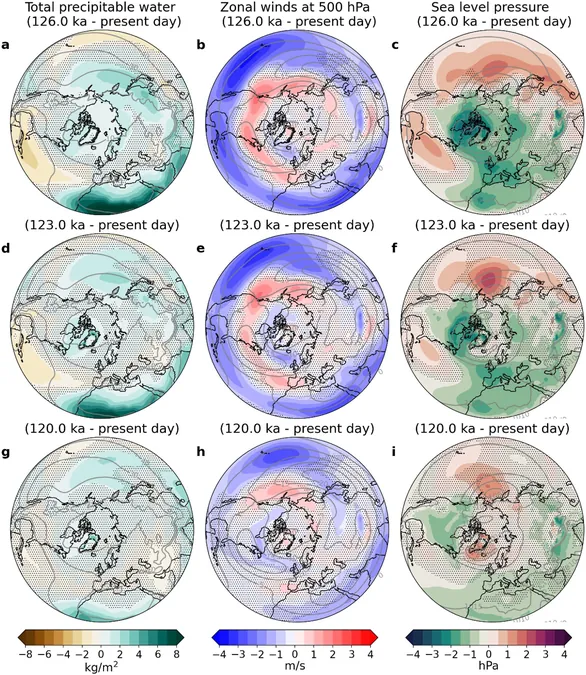
Sky Rivers and Arctic Melting: A Deep Dive into Greenland's Future
2025-09-22
Author: Wei
What Are Atmospheric Rivers?
Atmospheric rivers are massive weather phenomena that resemble 'rivers in the sky,' often bringing extreme conditions and widespread precipitation. Though commonly associated with areas like California, these atmospheric systems have global implications, impacting temperatures and rainfall in mid- and high-latitude regions.
New Research Unveils Dark Predictions For the Greenland Ice Sheet
A team of scientists from the University of Connecticut, led by associate professor Clay Tabor and Ph.D. student Joseph Schnaubelt, has shed light on how these atmospheric rivers may be exacerbating the melting of the Greenland Ice Sheet. Their groundbreaking study, published in AGU Advances, dives into historical climate data to better understand future risks as the planet warms.
Lessons from the Last Interglacial Period
Focusing on the Last Interglacial period, which spanned from 130,000 to 115,000 years ago, the researchers aimed to determine how the Arctic will respond to ongoing climate change. Schnaubelt notes, "This was the last time the Arctic was warmer than today, and we're heading in that direction again." Understanding historical patterns can provide critical insight into future impacts.
Dual Effects of Atmospheric Rivers on Ice Melting
The dual nature of atmospheric rivers complicates their impact on ice sheets. While they can significantly increase snowfall, leading to greater ice accumulation, they also bring warmer air, resulting in enhanced rainfall and melting. The researchers emphasize these complexities since melting ice contributes directly to rising sea levels.
Innovative Data Analysis for Climate Insights
Using advanced simulations from the National Center for Atmospheric Research, the team analyzed how orbital changes affected atmospheric rivers during the Last Interglacial period. Schnaubelt explained, "During warmer orbital conditions, we observed an uptick in summertime storms hitting the ice sheet. This is concerning as we already know the Arctic is heating up, which could mean more summertime storms and increased ice melt ahead."
Elevation Matters: The Impact of Altitude on Ice Dynamics
An intriguing finding from the research is that the effects of atmospheric rivers vary by elevation. At lower altitudes, rain is more prevalent, while at higher elevations, storms cool and precipitate as snow. As the ice sheet shrinks and elevation decreases, the risk of rain increases, hastening the melting process.
The Bigger Picture: Small Temperature Changes, Huge Impacts
Tabor emphasizes the importance of understanding even seemingly minor temperature changes. "While a 1°C increase might not sound significant, it can shift climate extremes," he points out. The Arctic, for example, has warmed by 3°C to 5°C, leading to alarming sea-level rises between 6 to 9 meters (20 to 30 feet). Historical patterns demonstrate how small temperature shifts can spell disaster.
A Cautionary Tale for Today's Climate
While the circumstances of the past cannot be perfectly equated to today’s situation due to differing orbital effects, Tabor warns that there are more similarities than we might like to acknowledge. Increased atmospheric activity from small amounts of warming could severely impact sea levels and global climate patterns.
The Lasting Effects of Ice Melting
The study found that the most significant melt signals from atmospheric rivers occurred early in the Last Interglacial but that the ice sheet's minimum loss lagged. This highlights the long-term nature of ice sheet responses to climate signals. Tabor noted, "Even if CO2 emissions cease, the ice sheets may remain out of sync for thousands of years, continuing to melt long after temperatures begin to fall."
Need for Continued Research and Support
The research underlines the necessity for ongoing studies in climate science, made possible by resources like the NCAR simulation project. Tabor advocates for continued federal support for such projects, acknowledging the substantial scientific contributions they facilitate. As climate change continues to present unprecedented challenges, these insights are more crucial than ever.



 Brasil (PT)
Brasil (PT)
 Canada (EN)
Canada (EN)
 Chile (ES)
Chile (ES)
 Česko (CS)
Česko (CS)
 대한민국 (KO)
대한민국 (KO)
 España (ES)
España (ES)
 France (FR)
France (FR)
 Hong Kong (EN)
Hong Kong (EN)
 Italia (IT)
Italia (IT)
 日本 (JA)
日本 (JA)
 Magyarország (HU)
Magyarország (HU)
 Norge (NO)
Norge (NO)
 Polska (PL)
Polska (PL)
 Schweiz (DE)
Schweiz (DE)
 Singapore (EN)
Singapore (EN)
 Sverige (SV)
Sverige (SV)
 Suomi (FI)
Suomi (FI)
 Türkiye (TR)
Türkiye (TR)
 الإمارات العربية المتحدة (AR)
الإمارات العربية المتحدة (AR)